I first met Arnaldo Pomodoro in his Milanese studio on the Navigli. It was the early 2000s. At the time he was working on the first edition of his catalog raisonné of sculpture, but he was also absorbed in an ambitious and laudable cultural project: to inaugurate, a couple of years later, his Foundation’s museum in a former industrial space that had been entirely renovated and dedicated to modern and contemporary sculpture, the promotion of young talent, and research into his work as a sculptor. I remember him taking me on a tour of the site and telling me about what was going to be there. At that moment I could not imagine that I would be working there, for him, and that more than fifteen years later I would be the one to involve him in an exhibition project and accompany him to see it realized. Instead, that’s exactly what happened. And the title of this exhibition ’betrays’ this personal side of the story.
Arnaldo Pomodoro. {sur}face comes from a play on words between the term “surface”(surface) and the term “face”(face), which highlights its double level of reading: the man who takes off the mask of the artist, like an actor who takes off the clothes of his character, and vice versa, in a continuous short circuit between reality and fiction, between art and real life. {sur}face recounts, in fact, a never-before-seen aspect of Arnaldo Pomodoro’s art: the man before the work with his aspirations and hopes, the human frailties that, concealed behind the artist’s mask, gave rise to unique and unrepeatable works with hollowed-out and tormented surfaces. The scenic projects, large-scale works and environmental installations are tangible evidence that the man-artist has tirelessly sought the complexity of reality in perfect forms, corroding them with a powerful informal sign, instinctive but always rational, capable of revealing the deception of the senses when life is lived only superficially. {sur}face is a timelapse journey into Arnaldo Pomodoro’s interiority to discover the passions that stimulated his creativity and oriented his critical gaze toward life and history. The theatrical mask that the actor wears, handing the limelight to his character, and the subterranean labyrinth that he disorients by winding incessantly around himself are the boundaries of a mental space within which Arnaldo Pomodoro struggles to delimit his yearning for infinitude, a metaphor for the freedom and serenity that every human being should deserve. {sur}face is a total experience, spatial and virtual, analog and digital, to know man.
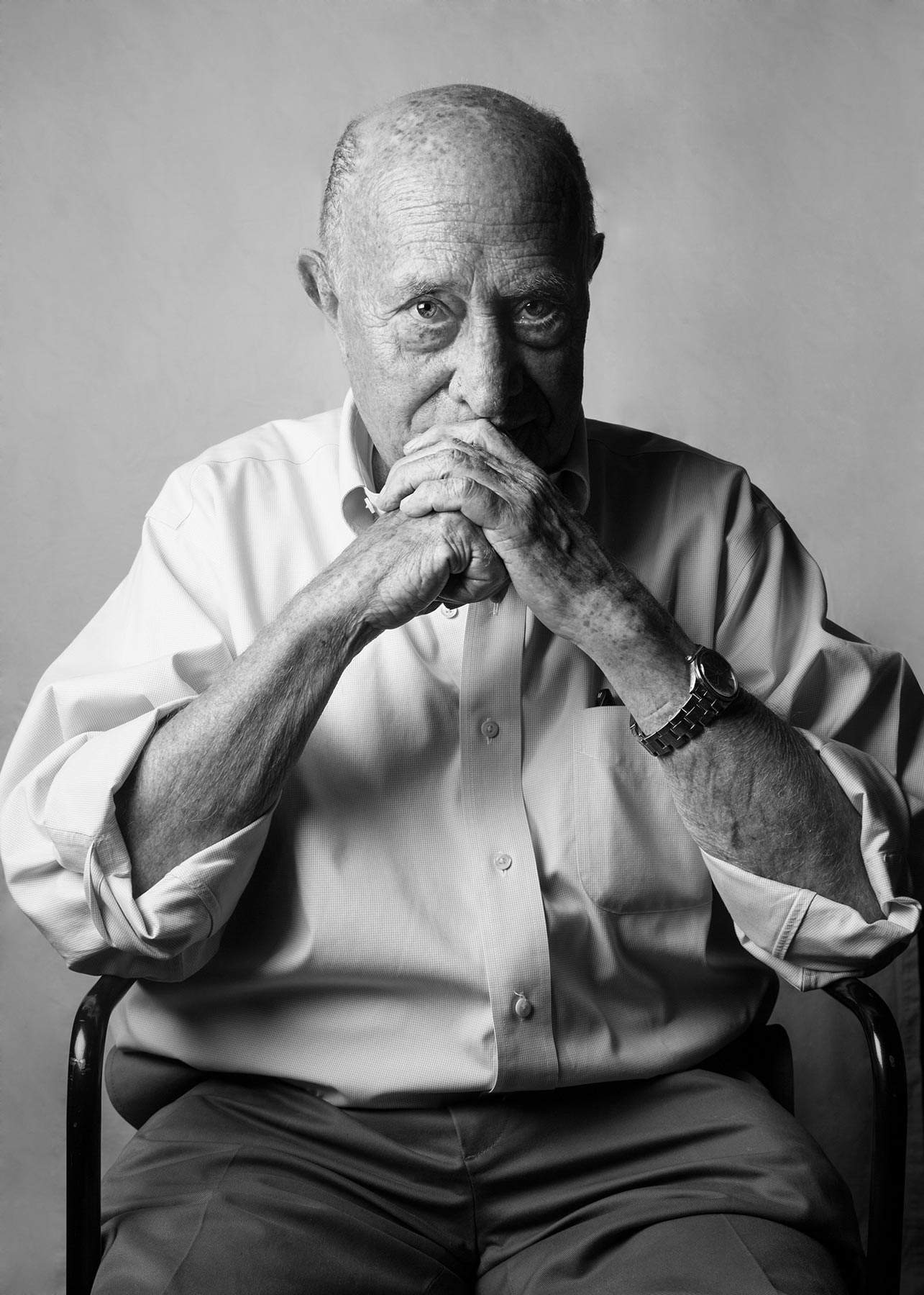 |
| Arnaldo Pomodoro (2014) © Nicola Gnesi for Fondazione Henraux |
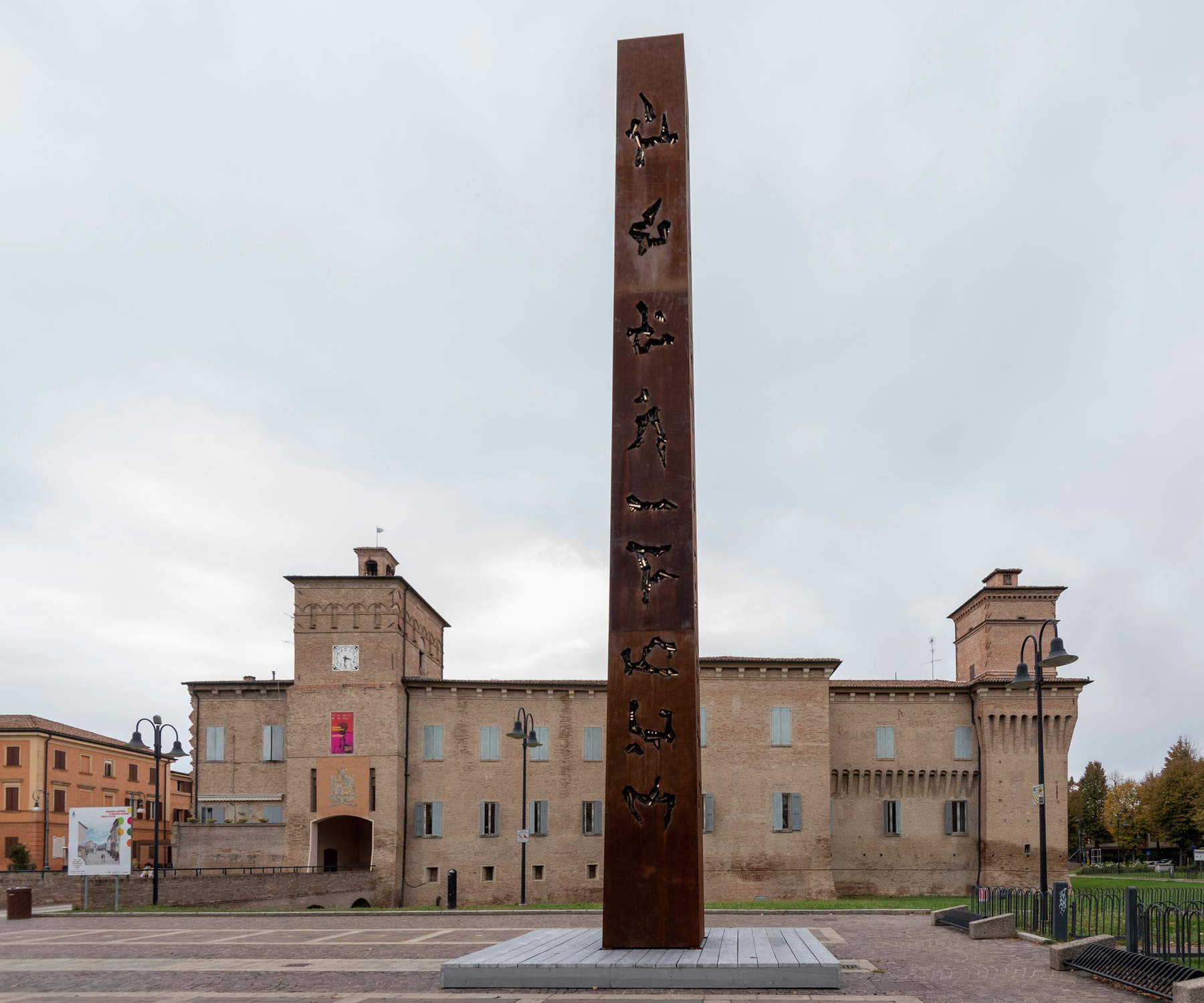 |
| Arnaldo Pomodoro, Obelisk for Cleopatra (1989-2008; corten and bronze, 14 x 1.40 x 1.40 m; Soliera, Piazza Lusvardi). Solierese Photo Studio. |
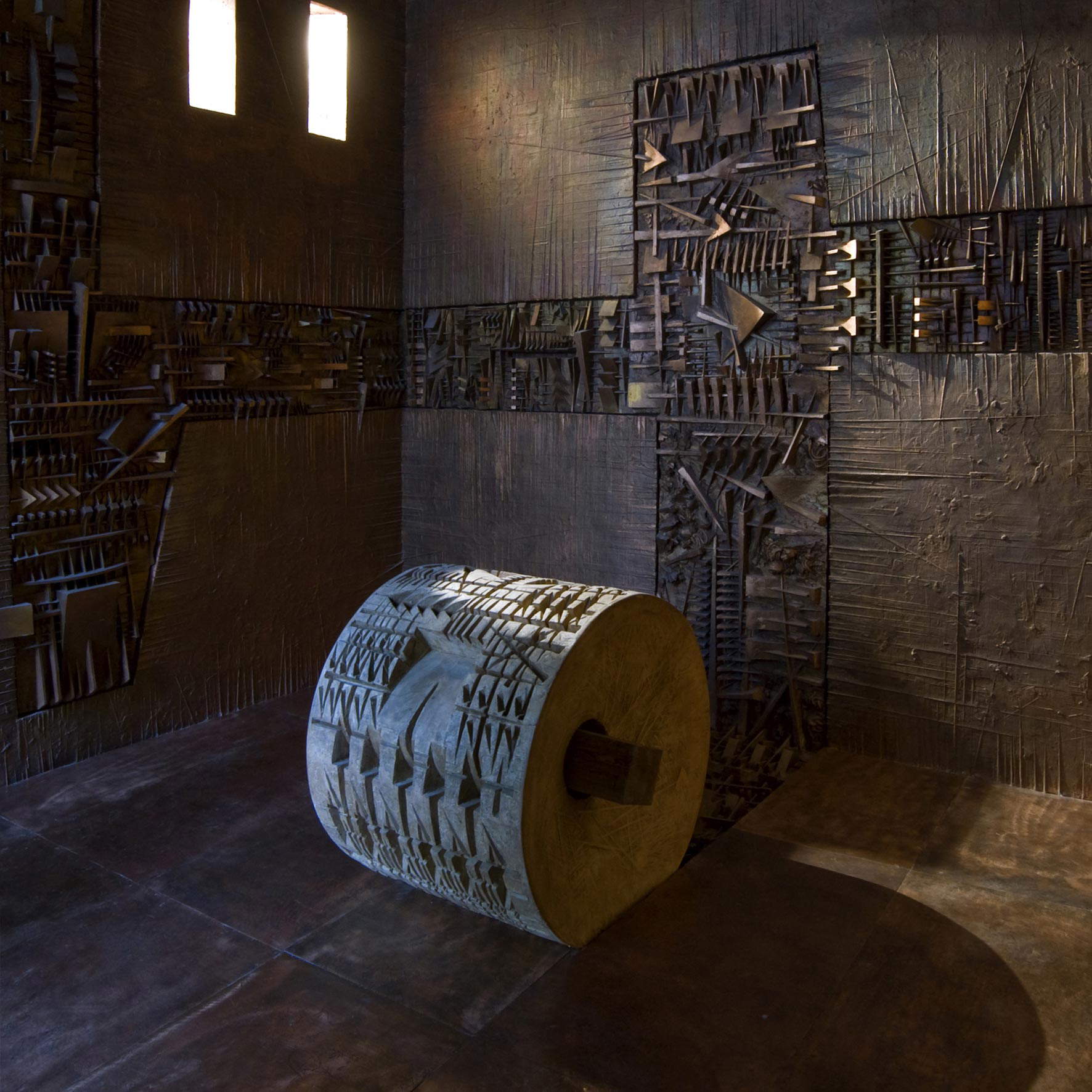 |
| Arnaldo Pomodoro, Entrance into the Labyrinth (1995-2011; view of the rotary press room). Photo Dario Tettamanzi |
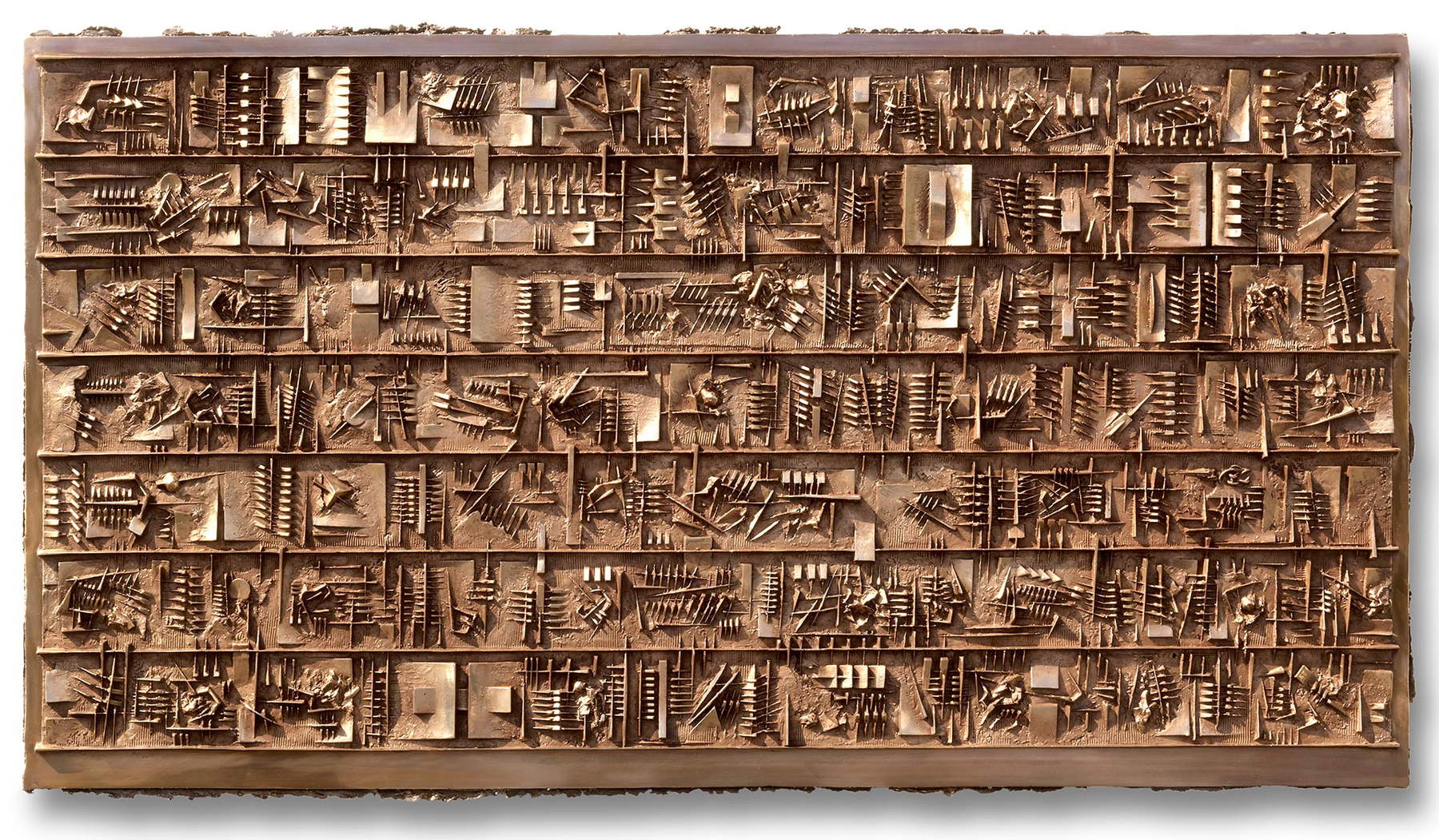 |
| Arnaldo Pomodoro, Continuum 2 (2010). Photo by Dario Tettamanzi |
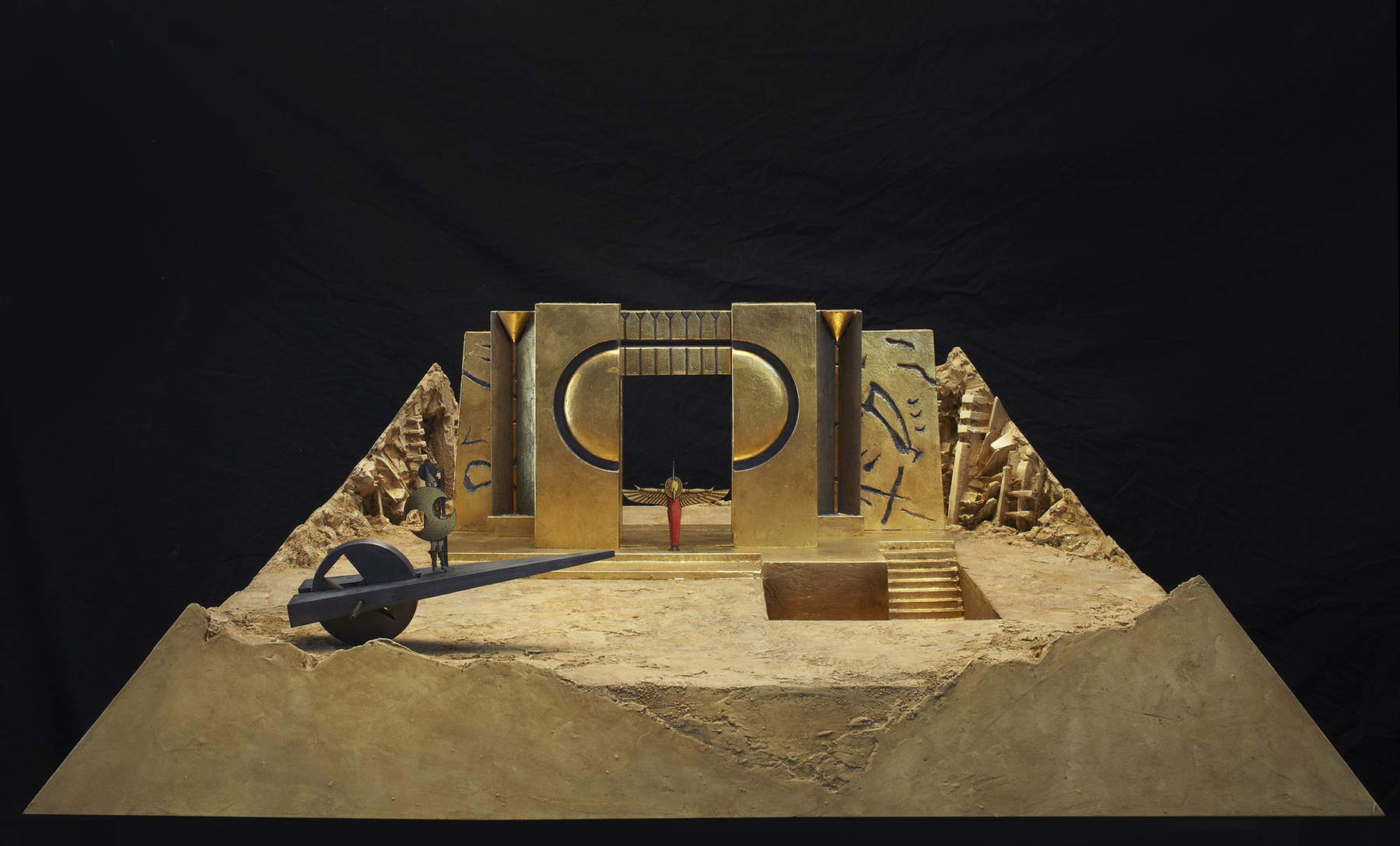 |
| Arnaldo Pomodoro, Model of the scene with the palace temple for Ahmad Shawqi’s The Passion of Cleopatra, Gibellina (1989). Photo Aurelio Barbareschi |
The exhibition itinerary is divided into two distinct parts, which we can define as thealpha andomega of Arnaldo Pomodoro’s career: the theater, which allowed him his first experiences of sculpture on a monumental scale; the habitable sculpture in the form of a labyrinth, which represents the summa of his signs as well as the imperishable testimony of his sculpture-making. The first part is devoted to the staging for Ahmad Shawqi’s The Passion of Cleopatra and presents the original stage costumes, preparatory drawings and set sketches, as well as photographs and videos of the performance. The second part of the exhibition, on the other hand, recounts the genesis of Ingresso nel labirinto (1995-2011), a 170-square-meter environmental work made of copper leaf-coated fiberglass constructed in the basement of the former Riva-Calzoni building in Milan (formerly the home of the Fondazione Arnaldo Pomodoro), through the reliefs Untitled (2005) and Continuum (2010) and Ingresso nel labirinto, studio (2011-2020), made especially for this exhibition and exhibited to the public for the first time. In the last room, visitors can experience Labyr-Into, one of the first immersive applications in contemporary art in Italy and the first ever dedicated to a work by Arnaldo Pomodoro, based on Gear’VR’ and ’Oculus’RifT technology. The project, created by Oliver Pavicevic and Steve Piccolo, constitutes a free interpretation of Entrance into the Labyrinth, in its 3D version, a work within the work, as well as within the work. The exhibition is also characterized by the room dedicated to younger children, designed and set up at ’child height’ and equipped with audio and video teaching aids, which allow children who cannot yet read to have direct experience with Arnaldo Pomodoro’s works without the mediation of an adult and thus feel that they are ’within their reach,’ a bit like the toys and drawings in their bedrooms.
Outside the exhibition, in front of Castello Campori, to ’mark’ the public urban space, we placed one of Arnaldo Pomodoro’s most important monumental sculptures, the one that symbolically marked the entrance of his Foundation in Milan. It is theObelisk for Cleopatra, granted on free loan to the City of Soliera for three years, a fourteen-meter-high work designed in 1989 for The Passion of Cleopatra by the Egyptian poet Ahmad Shawqi, staged on the ruins of Gibellina under the direction of Cherif in the summer of 1989 as part of the Orestiadi Festival and then made in 2008 in corten steel and bronze. The four vertical faces present a series of emblematic and symbolic signs that refer to Egyptian hieroglyphics and the informal sign typical of the sculptor. The chromatic diversity between the rusted corten shaft and the patinated bronze inserts lends solemnity to the work, which deeply connotes the public space in which it is installed. In the case of Lusvardi Square, the comparison is direct with both the urban context of the historic center and the massive medieval architecture of Campori Castle with its tower and the remains of the defensive moat. “When I received the first photos of the urban space,” says Arnaldo Pomodoro, "in which we would place one of my sculptures, I immediately thought of theObelisk for Cleopatra because of its symbolic charge. I am very pleased that my Obelisk has now found its ideal location in the striking square of Soliera, where it will remain for the next three years. I think that the work makes sense when it transforms the place where it is placed: then it gives new value to the spatial setting and really has a testimonial value of its time, it succeeds in imprinting a context with itself, to enrich it with further layers of memory."
The real challenge of {sur}face is precisely this, that the community identifies with Arnaldo Pomodoro and his art through the custom of his Obelisk in the city.
Warning: the translation into English of the original Italian article was created using automatic tools. We undertake to review all articles, but we do not guarantee the total absence of inaccuracies in the translation due to the program. You can find the original by clicking on the ITA button. If you find any mistake,please contact us.